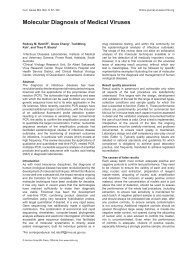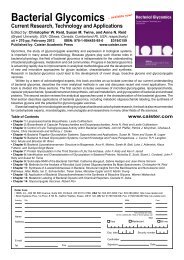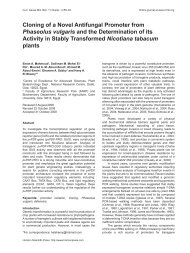Molecular Diagnostics of Medically Important Bacterial Infections
Molecular Diagnostics of Medically Important Bacterial Infections
Molecular Diagnostics of Medically Important Bacterial Infections
You also want an ePaper? Increase the reach of your titles
YUMPU automatically turns print PDFs into web optimized ePapers that Google loves.
24 Millar et al.<br />
a double-stranded molecule, or duplex or hybrid. The<br />
single-stranded molecules can be RNA or DNA, and the<br />
resultant hybrids formed can be DNA-DNA, RNA-RNA, or<br />
DNA-RNA. Hybridization assays require that one nucleic<br />
acid strand (the probe) originates from an organism <strong>of</strong><br />
known identity and the other strand (the target) originates<br />
from an unknown organism to be detected or identified.<br />
The probes are capable <strong>of</strong> identifying organisms at,<br />
above, and below the species level. Hybridization<br />
reactions can be done using either a solution format or<br />
solid support format. The solid support formats include:<br />
filter hybidizations, sandwich hybridizations, and in<br />
situ hybridizations. Nucleic acid hybridization methods<br />
were developed in the 1970s, and they are still used in<br />
microbial detection and identification today. They are also<br />
the important detection tools in real-time PCR such as<br />
TaqMan and LightCycler platforms.<br />
Polymerase chain reaction (PCR)<br />
Principle <strong>of</strong> PCR<br />
Polymerase Chain Reaction (PCR) is an enzyme-driven,<br />
primer-mediated, temperature-dependent process for<br />
replicating a specific DNA sequence in vitro. The principle<br />
<strong>of</strong> PCR is based on the repetitive cycling <strong>of</strong> three simple<br />
reactions, the conditions <strong>of</strong> which vary only in the<br />
temperature <strong>of</strong> incubation. The three simple reactions<br />
include:<br />
1. Denaturing: When the temperature is raised to around<br />
95 o C, template DNA double strand is separated to<br />
two single strands.<br />
2. Annealing: When the temperature reduces to approx.<br />
55 o C, two specific oligonucleotide primers bind to the<br />
DNA template complementarily.<br />
3. Extension: When the temperature rises to 72 o C, DNA<br />
polymerase extends the primers at the 3’ terminus<br />
<strong>of</strong> each primer and synthesizes the complementary<br />
strands along 5’to 3’ terminus <strong>of</strong> each template DNA<br />
using desoxynucleotides containing in media. After<br />
extension, two single template DNA strands and two<br />
synthesized complementary DNA strands combine<br />
together forming two new double strand DNA copies.<br />
After extension, the reaction will repeat above steps.<br />
Each copy <strong>of</strong> DNA may then serve as another<br />
template for further amplification. PCR products will<br />
be doubled in each cycle. After n cycles (approx. 30),<br />
the final PCR products will have 2 n copies <strong>of</strong> template<br />
DNA in theory and it just needs few hours.<br />
Specific PCR<br />
Specific PCR is the simplest PCR approach <strong>of</strong> which is<br />
designed for detecting specific target microbes. In specific<br />
PCR, primers are designed complimentary to a known<br />
DNA target and specific for the microbe being assayed.<br />
This is a key point for specific PCR so that the primers<br />
should be so-designed so that they are strictly specific for<br />
the targeted microorganisms. As the result is specific for<br />
the detection <strong>of</strong> target microbes, this method can be used<br />
as a direct detection and identification method. This is the<br />
most widely used method in the diagnosis <strong>of</strong> infectious<br />
diseases. Many organisms, such as Mycobacterium<br />
tuberculosis, pneumococci, meningococci and<br />
Burkholderia cenocepacia, can be identified by specific<br />
PCR directly.<br />
Multiplex PCR<br />
In multiplex PCR, two or more primer pairs are included<br />
in one reaction tube and two or more DNA templates<br />
are targeted simultaneously. This is a relatively simple<br />
molecular way to detect few different bacteria in one PCR<br />
reaction. In multiplex PCR, the primer pairs should be<br />
specific to the target gene and the PCR products should<br />
be in different sizes.<br />
Nested/semi-nested PCR<br />
In this approach, genomic template DNA is amplified with<br />
two sets <strong>of</strong> primers. The first PCR set produces a larger<br />
PCR product than that in second PCR set. The second<br />
PCR set uses the first PCR product as template DNA<br />
to amplify an internal region <strong>of</strong> DNA during the second<br />
(nested/semi-nested) amplification stage. The primers<br />
in the second PCR set can be different to the first set<br />
(nested) or one <strong>of</strong> the primers can be the same as the first<br />
set (semi-nested). This method can be used to increase<br />
the sensitivity <strong>of</strong> detection or to identify the first set PCR<br />
products when the primers in the second PCR reaction<br />
are species-specific.<br />
Broad range PCR<br />
Broad range PCR is a very useful approach for detecting<br />
microbes universally. The primers in broad range PCR are<br />
selected from the conserved regions <strong>of</strong> a particular gene<br />
that is shared by a given taxonomic group. This crucial<br />
important for broad range PCR to select real broad range<br />
primes. As the 16S rRNA gene is found in all bacteria<br />
and contains certain conserved regions <strong>of</strong> sequence, it<br />
has been mostly used as the broad range PCR target<br />
gene for detecting bacteria. The 23S rRNA is similar with<br />
the 16S rRNA gene and it may also be used to a lesser<br />
extent, as the broad range PCR target gene. Given that,<br />
there is relatively limited information regarding the 23S<br />
rRNA gene, this gene locus gene is not so popular, in<br />
comparison with the 16S rRNA gene. Another region <strong>of</strong><br />
the rRNA machinery that is used in broad range PCR is<br />
the inter-spacer (ITS) region between 16S and 23S rRNA<br />
genes. In this broad range PCR approach, the forward<br />
primer is from 16S rRNA gene, and the rewords primer<br />
is form 23S rRNA gene. An example <strong>of</strong> the arrangement<br />
<strong>of</strong> the rRNA operons is illustrated with the obligate Gram<br />
+ve intracellular pathogen, Tropheryma whipplei.<br />
1. Nested PCR: After broad range DNA amplification,<br />
species-specific primers are used in tandem with a<br />
second set <strong>of</strong> DNA amplification primers. The result<br />
can be detected by standard gel electrophoresis.<br />
2. DNA probe hybridization: The broad range PCR<br />
products can be identified by using species-specific<br />
DNA probe hybridization. The probe and the PCR<br />
products are incubated together in a single test tube,<br />
and the binding <strong>of</strong> probe to the target is measured.<br />
3 DNA enzyme immunoassay (DEIA): In this method,





